Introduction
The continuous problem and discretization
The construction of VEM and error analysis
Numerical case
The Virtual Element Method on the
two-dimensional Laplace equation
June 27, 2020
�
Introduction
The continuous problem and discretization
The construction of VEM and error analysis
Numerical case
content
Introduction
The continuous problem and discretization
The construction of VEM and error analysis
Numerical case
�
Introduction
The continuous problem and discretization
The construction of VEM and error analysis
Numerical case
Introduction
The virtual element method is a generalisation of the standard
conforming finite element method for the approximation of solutions
to partial differential equations. The method is designed in such a
way as to enable the construction of high order approximation spaces
which may include an arbitrary degree of global regularity on meshes
consisting of very general polygonal (or polyhedral) elements. In this
report, We preserve the generality of the shape of the elements in
the decomposition of the computational domain, and the generality
in the degree k of accuracy that we require to the method.Finally,
We give the numerical example.
�
Introduction
The continuous problem and discretization
The construction of VEM and error analysis
Numerical case
Throughout the paper, we will follow the usual notation for
Sobolev spaces and norms.In particular,for an open bounded do-
main D,we will use | · |s,D and · s,D to denote seminorm and
norm,respectively,in the Sobolev space H s (D),while (·,·)0,D will de-
note the L2(D) inner product.Often the subscript will be omit-
ted when D is the computational domain Ω.For k a non-negative
integer,Pk (D) will denote the space of polynomials of degree ≤ k on
D.Conventionally, P−1(D) = 0. Moreover, P D
k will denote the usual
L2(D)-orthogonal projection onto Pk (D). Finally, C will be a generic
constant independent of the decomposition that could change from
one occurrence to the other.
�
Introduction
The continuous problem and discretization
The construction of VEM and error analysis
Numerical case
The continuous problem and discretization
We consider the problem
− u = f
in Ω, u = 0 on Γ = ∂Ω,
(2.1)
where Ω ⊂ R2 is a polygonal domain and f ∈ L2(Ω). The variational
formulation reads:find u ∈ V := H 1
0 (Ω) such that
a(u, v ) = (f , v ) ∀v ∈ V ,
(2.2)
with(·,·)=scalar product in L2,a(u, v ) = (u,v ),|v|2
1 = a(v , v ).
�
Introduction
The continuous problem and discretization
The construction of VEM and error analysis
Numerical case
It is clear that seminorm | · |1 is a norm on H 1
0 (Ω),because if we set
|v|1 = 0,then with Poincar´e inequality, we have v1 ≤ C|v|1 = 0,so
we have v ≡ 0 on Ω.With Cauchy Schwartz inequality,it is also well
known that
a(v , v ) ≥ |v|2
1
and
a(u, v ) ≤ |u|1|v|1,∀u, v ∈ V
(2.3)
So problem (2.2) has a unique solution.
�
Introduction
The continuous problem and discretization
The construction of VEM and error analysis
Numerical case
The discrete problem
Let {Th}h be a sequence of decompositions of Ω into elements
K ,and let εh be the set of edges e of Th.As usual,h will also denote
the maximum of the diameters of the elements in Th.
Next,we give some assumption:
A0.1. For every h, the decomposition Th is made of a finite
number of simple polygons (meaning open simply connected sets
whose boundary is a non-intersecting line made of a finite number
of straight line segments).
�
Introduction
The continuous problem and discretization
The construction of VEM and error analysis
Numerical case
The bilinear form a(·,·) and the norm | · |1 can obviously be
split as
a(u, v ) =
|v|1 = (
to the space H 1(Th) :=
K∈{Th}h
K∈{Th}h
H 1-seminorm:
aK (u, v ) ∀u, v ∈ V ,
|v|2
1,K )1/2 ∀v ∈ V .
(2.4)
Since in what follows we shall also deal with functions belonging
H 1(K ), we need to define a broken
K∈Th
|v|h,1 := (
K∈TH
|∇v|2
0,K )1/2
(2.5)
Note that, for discontinuous functions, this is really a seminorm and
not a norm: for instance, |Ch|h,1 ≡ 0 for every piecewise constant
function ch.
�
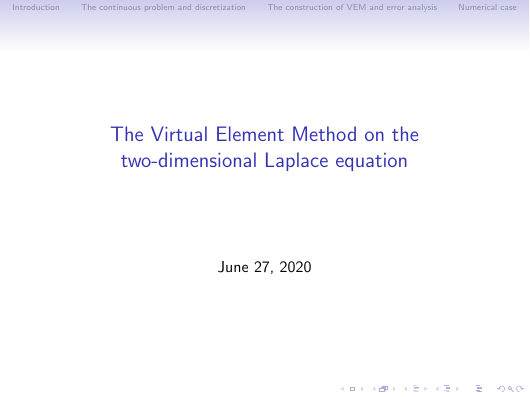


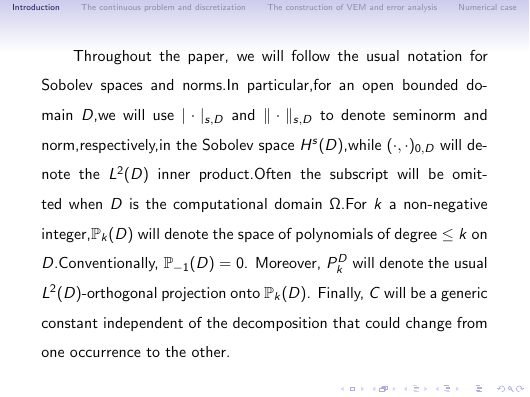
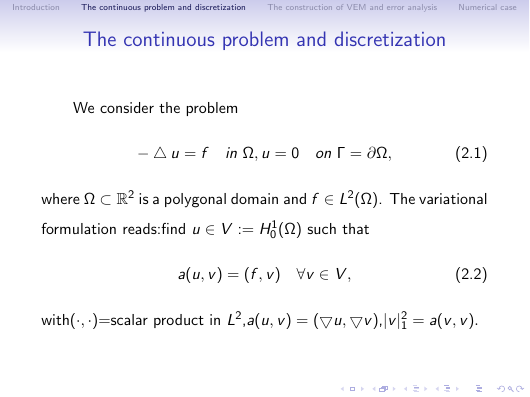
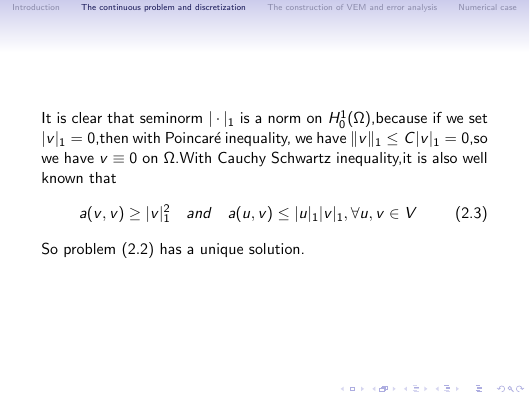
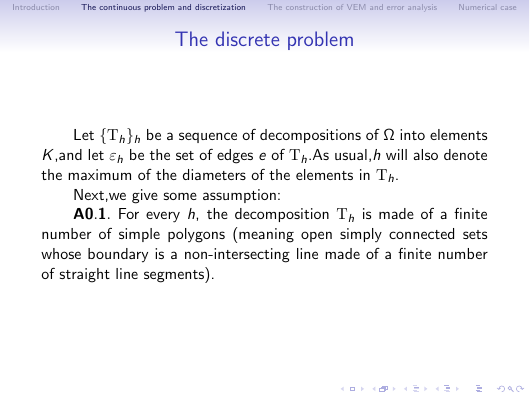









 2023年江西萍乡中考道德与法治真题及答案.doc
2023年江西萍乡中考道德与法治真题及答案.doc 2012年重庆南川中考生物真题及答案.doc
2012年重庆南川中考生物真题及答案.doc 2013年江西师范大学地理学综合及文艺理论基础考研真题.doc
2013年江西师范大学地理学综合及文艺理论基础考研真题.doc 2020年四川甘孜小升初语文真题及答案I卷.doc
2020年四川甘孜小升初语文真题及答案I卷.doc 2020年注册岩土工程师专业基础考试真题及答案.doc
2020年注册岩土工程师专业基础考试真题及答案.doc 2023-2024学年福建省厦门市九年级上学期数学月考试题及答案.doc
2023-2024学年福建省厦门市九年级上学期数学月考试题及答案.doc 2021-2022学年辽宁省沈阳市大东区九年级上学期语文期末试题及答案.doc
2021-2022学年辽宁省沈阳市大东区九年级上学期语文期末试题及答案.doc 2022-2023学年北京东城区初三第一学期物理期末试卷及答案.doc
2022-2023学年北京东城区初三第一学期物理期末试卷及答案.doc 2018上半年江西教师资格初中地理学科知识与教学能力真题及答案.doc
2018上半年江西教师资格初中地理学科知识与教学能力真题及答案.doc 2012年河北国家公务员申论考试真题及答案-省级.doc
2012年河北国家公务员申论考试真题及答案-省级.doc 2020-2021学年江苏省扬州市江都区邵樊片九年级上学期数学第一次质量检测试题及答案.doc
2020-2021学年江苏省扬州市江都区邵樊片九年级上学期数学第一次质量检测试题及答案.doc 2022下半年黑龙江教师资格证中学综合素质真题及答案.doc
2022下半年黑龙江教师资格证中学综合素质真题及答案.doc